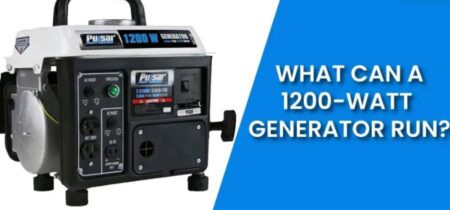
Parallel generators are a common choice for people who need more watts than a single generator can give. This procedure requires connecting two or more generators in order to boost the available power. However, the question of whether non-inverter generators, as opposed to inverter generators specially intended for this purpose, can be parallel-linked persists.
In this blog article, we will look into parallel non-inverter generators, their compatibility, and the methods needed to effectively link them. We will present a complete guide for individuals looking to parallel their non-inverter generators by analysing several parameters such as power and phase.
What does it mean to parallel generators?
Parallel generators are two or more generators that are connected together in order to increase the overall power output. When generators are paralleled, they work together to produce more electricity than they would individually. This is achieved by connecting the generators using special parallel cables, which combine the output of the generators to create a single power source.
Can you parallel non inverter generators?
It is possible to parallel non-inverter generators, but it can be challenging and requires careful consideration of several factors. Non-inverter generators are not designed to be run in parallel, and as a result, they may not have the necessary controls and connections to be connected to other generators. Additionally, non-inverter generators typically produce an unstable output, which can lead to fluctuations in the overall power supply when combined with other generators.
If you are considering parallel operation of non-inverter generators, it is essential to consult the manufacturer of the generators to ensure that they are suitable for parallel operation and to obtain guidance on the necessary controls and connections. Additionally, it is important to carefully monitor the output of each generator and make adjustments as necessary to ensure that the combined output is stable and consistent.
In summary, parallel operation of non-inverter generators is possible, but it requires careful planning, monitoring, and adjustments to ensure that the generators operate safely and effectively together.
How to parallel non inverter generators
Here are the general steps for parallelizing non-inverter generators:
- Choose generators with compatible voltage and frequency
Before attempting to parallelize non-inverter generators, it’s important to ensure that the generators are of the same type and have the same voltage and frequency ratings.
- Install load-sharing devices
Load-sharing devices, such as a synchronizer or governor controller, are used to ensure that the electrical loads are distributed evenly between the generators. This helps to prevent overloading of one generator and ensures a stable power supply.
- Synchronize the generators
Once the load-sharing devices are installed, you need to synchronize the generators to ensure that they are producing the same voltage and frequency. This can be achieved by adjusting the engine speed and voltage regulator of each generator to match the other generator’s output.
- Connect the generators in parallel
Once the generators are synchronized, you can connect them in parallel using a suitable switchgear or transfer switch. This switchgear should have the capability to manage the load sharing and protection functions required for the parallel operation.
- Monitor and maintain the parallel operation
Once the generators are in parallel, it’s important to monitor their performance and maintain them properly. Regular maintenance, such as oil changes and air filter cleaning, will help to ensure that the generators continue to operate smoothly and efficiently.
It’s worth noting that parallelizing non-inverter generators requires more effort and care compared to parallelizing inverter generators. It’s important to follow the manufacturer’s guidelines and seek the help of a professional if you’re unsure about any aspect of the parallelization process.
Advantages and Disadvantages of non inverter generators in parallel operations
Non-inverter generators are a popular choice for powering homes, businesses, and recreational vehicles. When more power is needed than a single generator can provide, parallel operation of non-inverter generators can be used to increase the overall power output. However, there are both advantages and disadvantages to using non-inverter generators in parallel operation. In this blog, we will explore these advantages and disadvantages to help you decide if parallel operation of non-inverter generators is the right solution for your power needs.
Advantages of non-inverter generators in parallel operations:
- Increased Power Output
The main advantage of parallel operation of non-inverter generators is the increased power output. By connecting two or more non-inverter generators together, you can combine their power output to create a single power source that is capable of powering large appliances or equipment. This is particularly useful in situations where a single generator cannot provide enough power, such as on a construction site or during a power outage.
- Cost-Effective
Non-inverter generators are generally less expensive than inverter generators, making them a more cost-effective solution for power needs. By using two or more non-inverter generators in parallel, you can achieve the same power output as a single inverter generator at a lower cost.
- Durability
Non-inverter generators are known for their durability and are capable of withstanding harsh environments and heavy usage. This makes them a reliable option for powering equipment or appliances in rugged conditions.
- Easy Maintenance
Non-inverter generators are relatively simple to maintain and repair. They have fewer parts and are generally easier to service than inverter generators. This means that if there is an issue with one of the generators in a parallel operation, it can be easily fixed or replaced.
Disadvantages of non-inverter generators in parallel operations:
- Noise Pollution
Non-inverter generators are known for their loud noise output. When two or more non-inverter generators are used in parallel, the noise level can increase significantly, making it difficult to communicate or work in the area. This can be a significant disadvantage in residential areas or public spaces.
- Fuel Consumption
Non-inverter generators tend to consume more fuel than inverter generators. When multiple non-inverter generators are used in parallel, the fuel consumption can increase significantly, resulting in higher costs and more frequent refueling.
- Limited Load Sharing
Non-inverter generators have limited load-sharing capabilities. This means that the load must be evenly distributed between the generators in a parallel operation. If one generator is overloaded, it can cause the other generators to become overloaded as well, resulting in potential damage to the generators or equipment being powered.
- Limited Voltage and Frequency Control
Non-inverter generators do not have the same level of voltage and frequency control as inverter generators. This means that there may be fluctuations in the power output when using non-inverter generators in parallel, which can be harmful to sensitive equipment or appliances.
Conclusion
In conclusion, parallel operation of non-inverter generators can be a cost-effective and reliable solution for power needs. The main advantage of parallel operation is the increased power output, which can be achieved at a lower cost than using a single inverter generator. However, there are also several disadvantages to using non-inverter generators in parallel operations, including noise pollution, fuel consumption, limited load sharing, and limited voltage and frequency control. When deciding whether or not to use non-inverter generators in parallel, it is important to consider these advantages and disadvantages to determine if it is the right solution for your specific power needs.
Not all non-inverter generators may be suitable for parallel operation due to various reasons.
Non-inverter generators may not be appropriate for parallel operation due to several reasons. Firstly, not all non-inverter generators are designed to operate in parallel and may require additional controls and connections to be connected to other generators. Secondly, non-inverter generators are unable to produce a consistent output, which can make it challenging to merge power outputs effectively. In contrast, inverter generators have a stable and reliable output, making them a better choice for parallel operation. As a result, it is crucial to consider the limitations of non-inverter generators and seek guidance from the manufacturer before attempting to operate them in parallel.
Also Read:
HOW TO FIX A GENERATOR NOT PRODUCING POWER
HOW TO CONNECT A GENERATOR TO A HOUSE WITHOUT TRANSFER SWITCH








